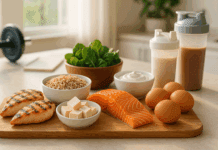Building muscle is not only a goal for bodybuilders and athletes, but also a vital component of long-term health, especially for women seeking strength, energy, and body composition improvements. When exploring how to gain muscle in women, it becomes clear that nutrition plays a critical role in the muscle-building equation. While exercise provides the necessary stimulus for growth, food delivers the building blocks and energy that enable that growth to occur. A high-protein diet, when designed strategically, offers a scientifically sound and safe method for women to increase lean muscle mass, improve strength, and support overall wellness.
You may also like : 5 Best Superfood Snacks: Nutrient-Dense Performance Boosters
Why Women Should Focus on Muscle Growth and Lean Mass
Historically, societal norms have skewed perceptions about women and muscle development, often framing strength training and muscle gain as masculine goals. However, contemporary health science highlights that muscle growth in women is essential for more than just physical aesthetics. Muscle mass supports metabolic health, bone density, hormonal balance, and functional strength, which become increasingly important with age. Furthermore, increased muscle helps combat the natural decline in lean body mass associated with aging, a process known as sarcopenia, which can begin as early as the 30s.
A well-structured muscle-building nutrition plan enables women to sculpt a physique that is not only stronger but also metabolically efficient. More muscle mass translates into a higher resting metabolic rate, meaning more calories are burned even at rest. This becomes a key advantage for women looking to manage weight, especially during hormonal transitions such as perimenopause or menopause. Muscle also contributes to glucose regulation, reducing the risk of insulin resistance and Type 2 diabetes. In essence, the pursuit of muscle growth is a strategic investment in long-term health.
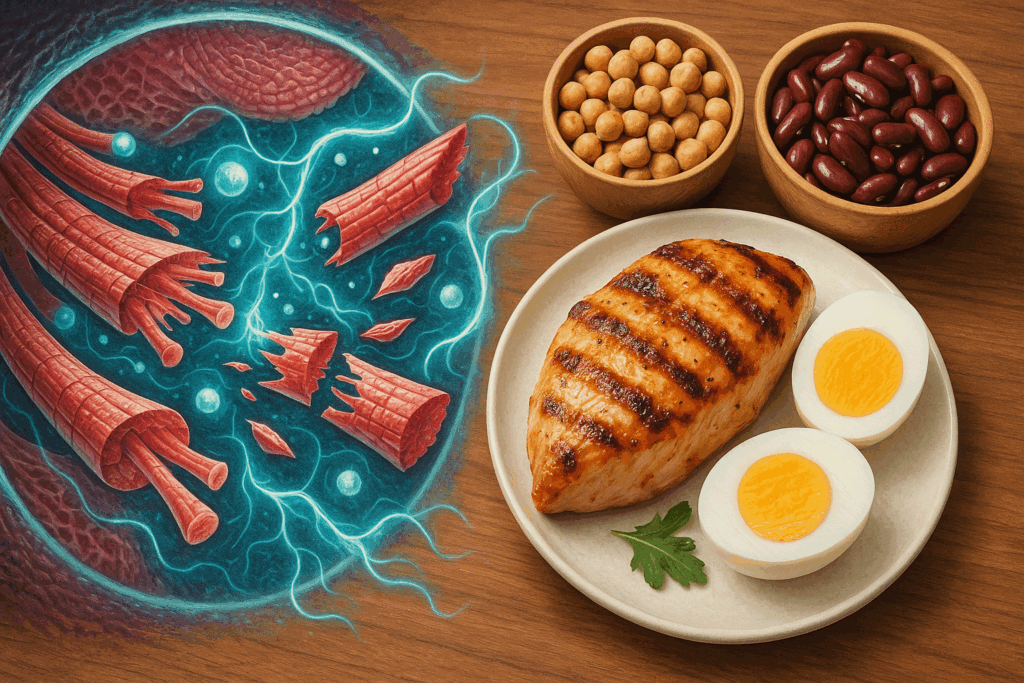
The Science of Protein and Muscle Growth
Protein is the primary macronutrient responsible for muscle repair and synthesis. When women engage in strength training or resistance exercises, microscopic tears occur in muscle fibers. Consuming adequate protein helps repair these tears and build new muscle tissue, a process known as muscle protein synthesis (MPS). The optimal environment for MPS includes both mechanical stimulus (exercise) and nutritional support (diet).
Protein requirements vary based on body weight, activity level, and training intensity. For women engaging in regular resistance training, research supports protein intakes of approximately 1.6 to 2.2 grams per kilogram of body weight per day. This means that a woman weighing 65 kilograms (143 pounds) would benefit from consuming 104 to 143 grams of protein daily to support muscle gain and recovery.
It’s also critical to distribute protein intake evenly across meals rather than concentrating it in a single serving. Studies show that consuming 25 to 35 grams of high-quality protein per meal maximizes muscle protein synthesis. High-quality protein sources include lean meats, poultry, eggs, dairy, fish, soy, legumes, and protein powders such as whey or plant-based blends.
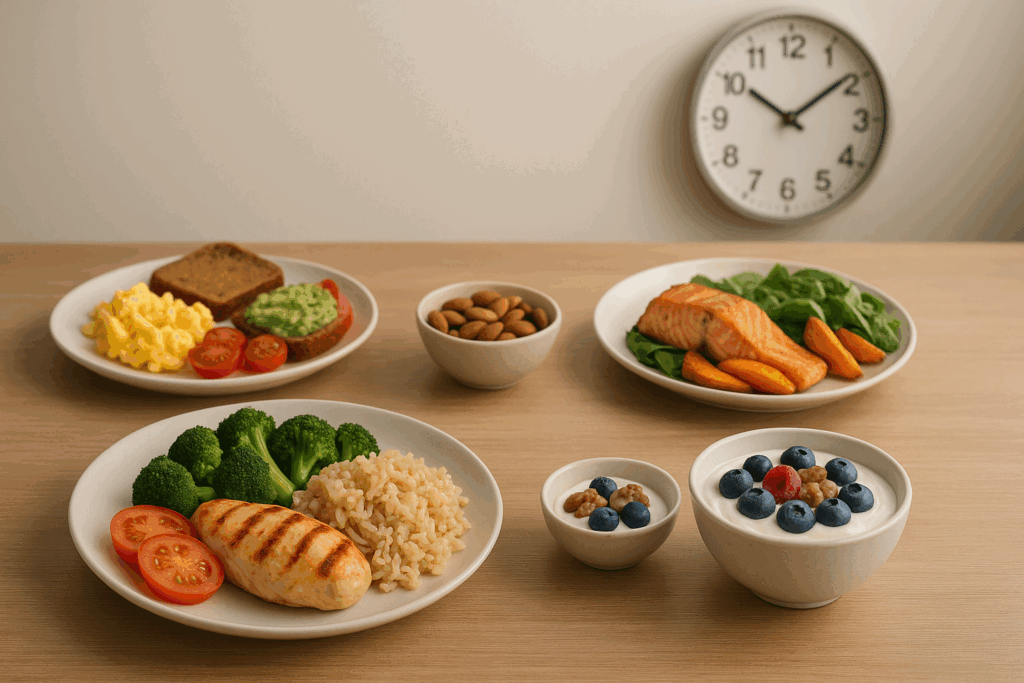
How to Gain Muscle in Women: Strategic Meal Timing and Macronutrient Balance
One of the most overlooked aspects of muscle gain is nutrient timing. The timing of meals and snacks can significantly influence recovery, energy availability, and hypertrophy. Consuming a balanced pre-workout meal that includes carbohydrates and protein ensures that energy levels are sufficient for training. Post-workout, it is essential to ingest protein along with a moderate amount of carbohydrates to replenish glycogen stores and initiate muscle repair.
For example, a post-workout meal could consist of grilled chicken breast with sweet potatoes and steamed broccoli or a protein smoothie made with whey protein, banana, and almond milk. This type of eating program to gain muscle is effective because it combines immediate fuel with the nutrients necessary for recovery. When these practices are consistently followed, they create an optimal environment for muscle building and repair.
In addition to timing, balancing macronutrients is vital. While protein is central, carbohydrates provide the primary fuel for high-intensity workouts, and fats support hormonal health. An effective muscle building diet for women often includes 40-50% of total calories from carbohydrates, 25-30% from protein, and 20-30% from healthy fats. This distribution ensures sufficient energy availability while promoting muscle hypertrophy and hormonal equilibrium.
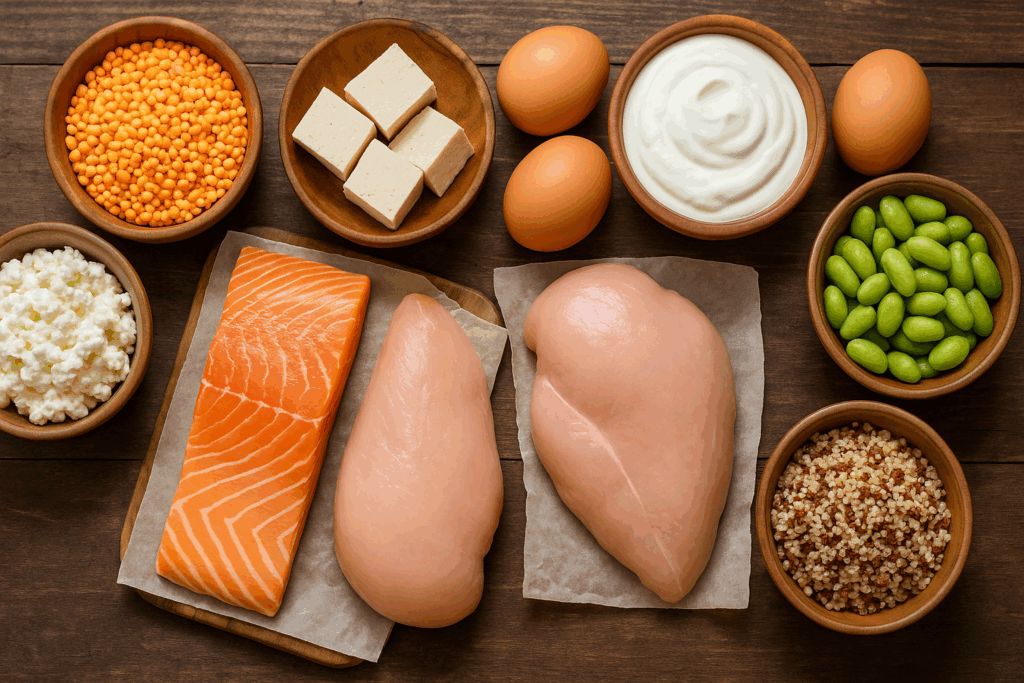
High-Protein Foods to Include in a Muscle Building Food Plan
The success of any muscle growth eating plan hinges on the quality and variety of foods included. Selecting nutrient-dense, high-protein foods ensures that women meet their dietary requirements without unnecessary caloric excess. Among the best foods to eat to gain muscle are lean meats such as chicken breast, turkey, lean beef, and pork tenderloin. These options are not only high in complete proteins but also rich in iron and B vitamins that support energy metabolism.
Fish, particularly fatty varieties like salmon and mackerel, contribute omega-3 fatty acids that reduce inflammation and support recovery. Dairy products such as Greek yogurt, cottage cheese, and low-fat milk provide both casein and whey protein, making them ideal for pre-sleep or post-exercise meals. Eggs offer a complete amino acid profile and are versatile in meals throughout the day.
For plant-based options, lentils, chickpeas, black beans, quinoa, tofu, tempeh, and edamame deliver protein alongside fiber and micronutrients. Incorporating a mix of animal and plant proteins enhances nutrient diversity and meal satisfaction. Protein powders can serve as convenient supplements to boost intake, particularly for women who struggle to meet their needs through whole foods alone.
Designing a Muscle Gain Eating Plan Tailored for Women
Creating a personalized muscle mass eating plan begins with understanding individual energy needs. Total daily energy expenditure (TDEE) must account for basal metabolic rate, physical activity, and exercise. A calorie surplus of 250 to 500 calories above maintenance is typically required to support muscle gain without excessive fat accumulation. Women may need to monitor their progress and adjust accordingly to maintain a lean mass focus.
Once caloric needs are established, the emphasis should shift to meal composition. A muscle building food plan might include five to six meals per day to optimize nutrient delivery and prevent hunger. Each meal should contain a protein source, a complex carbohydrate, and a healthy fat. For example, breakfast might feature oatmeal with protein powder and almond butter, while lunch could include grilled chicken, brown rice, and avocado.
Snacks are an opportunity to incorporate additional calories and nutrients. Hard-boiled eggs, protein bars, trail mix, and smoothies are efficient options. Hydration should not be overlooked; water supports muscle recovery, metabolic function, and digestion. While there is no one-size-fits-all approach, consistency in dietary habits is paramount to seeing sustainable progress.
What to Eat to Gain Muscle Mass: Practical Meal Examples and Strategies
Planning meals around whole, nutrient-rich foods can be both strategic and enjoyable. For breakfast, an egg scramble with spinach, feta cheese, and whole-grain toast supplies ample protein and fiber. Mid-morning snacks like Greek yogurt with berries provide a mix of fast-digesting and slow-digesting proteins. Lunch might include grilled salmon with quinoa and asparagus, delivering anti-inflammatory fats and complete protein.
Dinner could feature lean turkey meatballs with lentil pasta and roasted vegetables. Before bed, casein-rich foods like cottage cheese or a casein protein shake support overnight muscle protein synthesis. These examples show how to construct meals that align with a bodybuilding nutrition diet while keeping variety and palatability in mind. Batch cooking, prepping ingredients in advance, and using seasoning blends can help maintain adherence to a food program to gain muscle without sacrificing flavor.

How to Gain Muscle in Women Without Unwanted Fat Gain
Gaining muscle does not require bulking in the traditional sense of excessive caloric surpluses that often lead to unwanted fat gain. Women can strategically build muscle through a lean bulk approach, which emphasizes slow and controlled weight increases. This method requires meticulous tracking of food intake, body composition, and training progress.
Women should prioritize strength training over excessive cardio when aiming to gain lean muscle. Resistance exercises such as squats, deadlifts, lunges, bench presses, and rows activate large muscle groups and stimulate hypertrophy. Compound movements are especially effective because they engage multiple joints and require greater energy expenditure. Incorporating progressive overload—gradually increasing weights or repetitions—ensures continued adaptation and growth.
Monitoring biofeedback such as energy levels, menstrual regularity, recovery rate, and mood can help fine-tune the muscle increase diet plan. If fat gain begins to outpace muscle development, adjustments to macronutrient distribution or overall caloric intake may be necessary. Patience and persistence are essential, as significant muscle gain typically unfolds over several months.
How to Gain Muscle Fast for Women: Effective Strategies and Recovery Protocols
While sustainable muscle growth takes time, there are evidence-based strategies for how to gain muscle fast without compromising health. Prioritizing compound movements, training each muscle group at least twice per week, and ensuring adequate sleep are foundational. Women should aim for 7 to 9 hours of quality sleep nightly, as this is when most muscle repair and hormonal regulation occurs.
Nutritionally, consuming protein within 30 to 60 minutes after exercise supports recovery. Pairing protein with carbohydrates enhances nutrient uptake and glycogen replenishment. Creatine monohydrate is one of the most researched and effective supplements for increasing strength and lean mass, with no adverse effects when used responsibly.
Stress management also plays a critical role. Chronic stress elevates cortisol, a hormone that can inhibit muscle gain and increase fat storage. Practices such as mindfulness, yoga, and breathing exercises enhance recovery and mental resilience. Recovery is as important as training, and ensuring rest days, foam rolling, and stretching can prevent overtraining and injury.
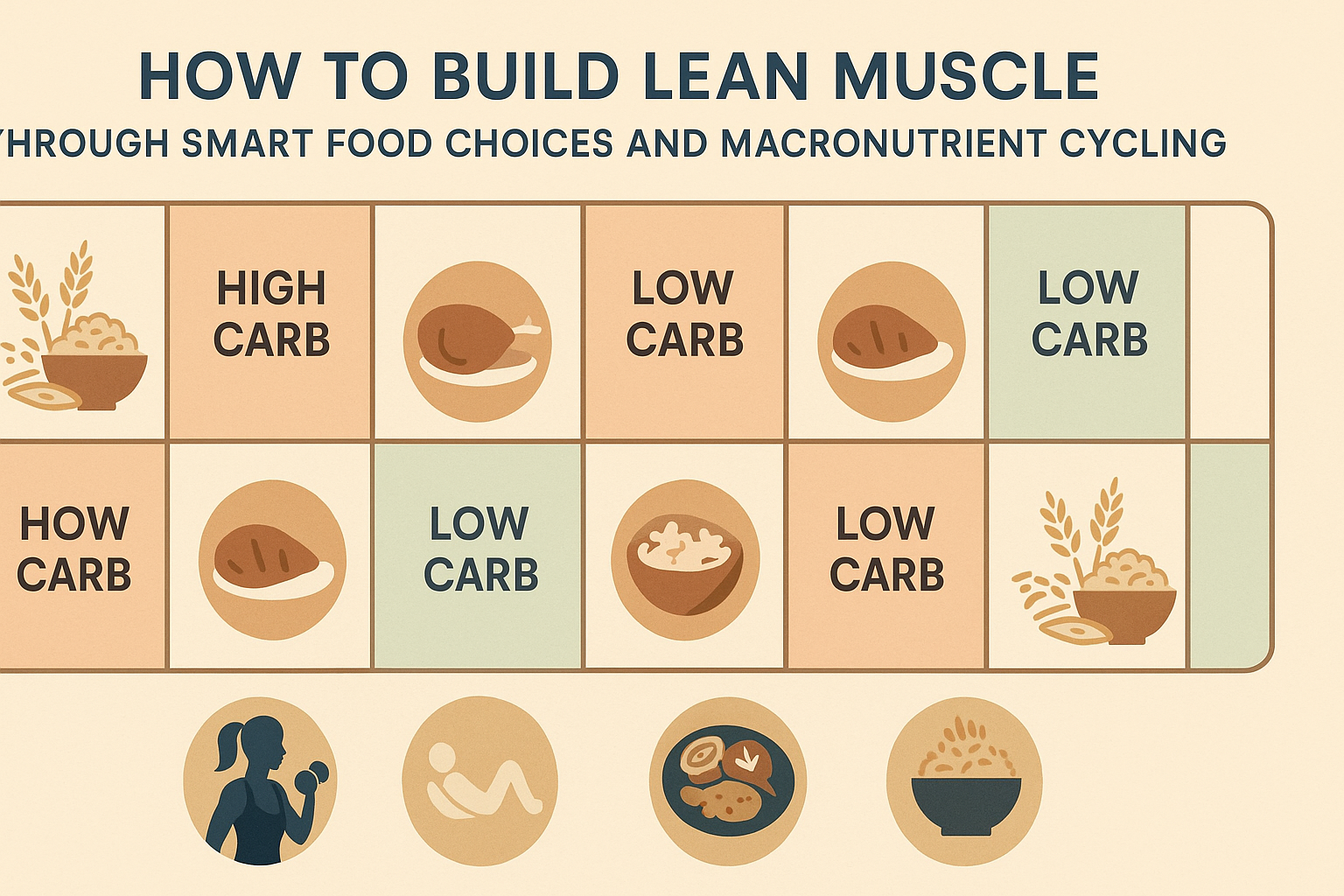
How to Build Lean Muscle Through Smart Food Choices and Macronutrient Cycling
Gaining muscle does not necessitate sacrificing leanness. Knowing how to build lean muscle involves smart food choices, macronutrient cycling, and nutrient timing. Macronutrient cycling alternates high-carb and low-carb days to align with training intensity. On heavy lifting days, higher carbohydrate intake fuels performance and recovery. On rest or low-intensity days, reducing carbs can minimize fat storage while maintaining protein intake to preserve muscle.
Fiber-rich carbs such as brown rice, oats, sweet potatoes, and legumes provide sustained energy and prevent blood sugar spikes. Healthy fats like olive oil, nuts, and seeds support hormonal function and enhance meal satisfaction. Protein remains consistent across all days to maintain positive nitrogen balance, which is essential for muscle repair.
This approach is particularly effective for women balancing strength goals with aesthetic preferences. Tracking progress through photos, strength logs, and measurements offers a more accurate picture than scale weight alone. The goal is to promote steady growth without unnecessary bulk.
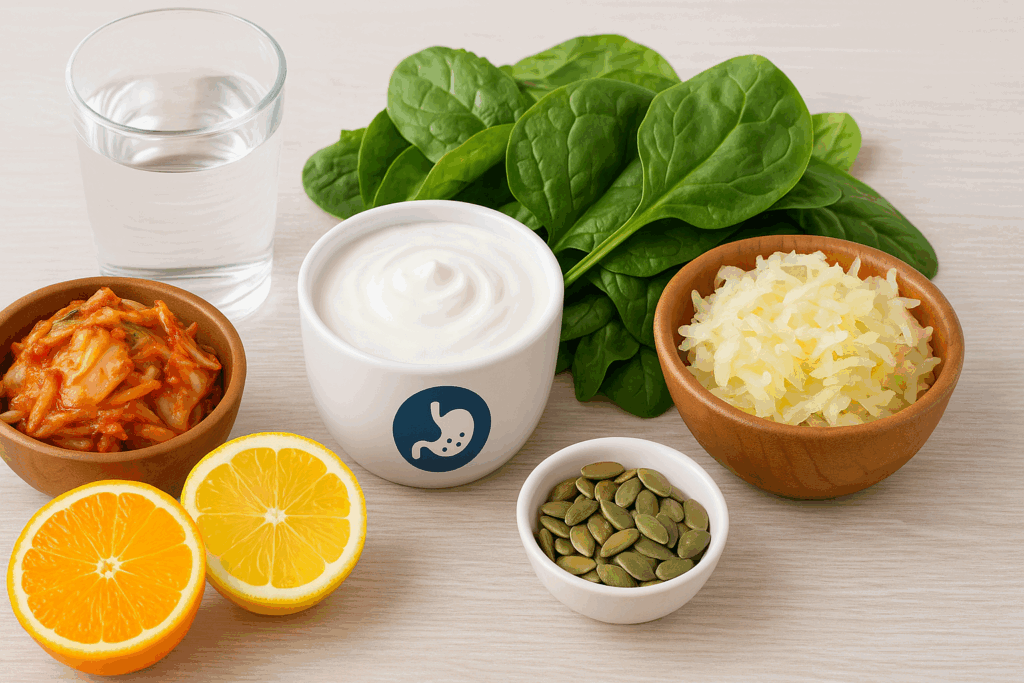
What to Eat to Build Muscle: The Role of Micronutrients and Digestive Health
While macronutrients often dominate the discussion, micronutrients are equally vital in a muscle gain eating plan. Magnesium, zinc, vitamin D, and B-complex vitamins support energy metabolism, muscle contraction, and protein synthesis. Iron is particularly important for women due to menstruation-related losses, and it supports oxygen transport and endurance.
Whole foods such as leafy greens, nuts, seeds, legumes, whole grains, and lean meats provide these essential nutrients. Supplementation may be warranted for women with deficiencies or increased needs. Additionally, digestive health influences nutrient absorption. A compromised gut may limit protein assimilation and impair muscle gain. Probiotic-rich foods like yogurt, kefir, sauerkraut, and miso enhance gut flora, while prebiotic fibers support their growth.
Hydration is often overlooked but is essential for nutrient transport, joint lubrication, and metabolic processes. Women aiming to build muscle should consume at least half their body weight in ounces of water daily, with adjustments for exercise intensity and climate.
How to Gain Muscle in Women: Overcoming Plateaus and Hormonal Barriers
At some point, most women encounter a plateau where muscle growth slows or stalls. These plateaus can be physical, hormonal, or behavioral. Addressing them requires a comprehensive approach that includes reevaluating training intensity, periodizing workouts, and ensuring dietary adequacy.
Hormonal fluctuations, particularly related to estrogen and progesterone, can affect strength, energy, and recovery. Tracking menstrual cycles can help women optimize training and nutrition based on hormonal phases. For instance, the follicular phase is often associated with increased strength and energy, making it ideal for progressive overload. During the luteal phase, a focus on recovery and maintenance may be more appropriate.
Chronic under-eating, overtraining, and sleep deprivation can suppress thyroid function and disrupt menstrual regularity, further impeding muscle growth. Addressing these factors through strategic deloads, refeed days, and stress management can reinvigorate progress.
Sleep, Stress, and Circadian Rhythm Alignment
Sleep quality directly influences muscle repair, hormonal regulation, and training output. Growth hormone and testosterone, which play key roles in muscle synthesis, are primarily secreted during deep sleep stages. Women experiencing sleep disruption due to lifestyle stressors, perimenopause, or parenting demands may see diminished recovery and muscle gain.
Optimizing sleep hygiene involves maintaining a consistent bedtime, limiting blue light exposure, avoiding caffeine late in the day, and keeping the sleep environment cool and dark. For women with chronic stress, prioritizing recovery becomes even more critical. Elevated cortisol not only impedes muscle gain but also increases fat storage, especially in the abdominal area.
Aligning daily routines with natural circadian rhythms enhances energy balance and training consistency. For instance, training in the late morning or early afternoon may align better with peak strength and cognitive function for many women. Eating meals at consistent times also supports metabolic regulation and nutrient partitioning.
Biofeedback, Intuitive Eating, and Adjusting Based on Progress
Tracking calories and macros offers structure, but long-term success often hinges on learning to listen to one’s body. Biofeedback refers to the signals your body sends about hunger, fullness, energy, sleep, performance, and mood. Incorporating intuitive eating within a structured muscle growth eating plan helps prevent disordered eating patterns and supports sustainable gains.
For example, if you consistently feel sluggish despite eating in a surplus, it might signal nutrient imbalance, poor food quality, or digestive issues. Likewise, excessive soreness or disrupted sleep may indicate overtraining or insufficient recovery nutrition. Journaling subjective experiences and correlating them with dietary habits provides valuable insight that no app or macro tracker can replicate.
Progress should also be tracked holistically. Instead of relying solely on scale weight, consider measurements, progress photos, gym performance, and how clothes fit. A woman may not see drastic changes on the scale but could experience significant improvements in body composition and strength.
Periodization and Strength Training for Female Physiology
Exercise periodization, or the planned variation of training variables over time, can maximize strength and muscle gains. For women, this includes alternating hypertrophy (higher reps and moderate weights) and strength (lower reps and heavier weights) cycles. These variations prevent plateaus and promote continuous adaptation.
Incorporating deload weeks—periods of reduced intensity or volume—allows the body to recover and prepares it for new growth phases. Functional training, including unilateral movements, balance work, and core integration, enhances joint stability and reduces injury risk. Women tend to have greater joint laxity due to estrogen, making prehab and corrective exercises essential.
Including plyometrics, such as jump squats and medicine ball slams, increases neuromuscular efficiency and metabolic rate. This can be particularly effective when combined with a muscle increase diet plan, helping to build strength without accumulating unnecessary body fat. Finally, addressing weak points such as posterior chain imbalances or core dysfunction ensures comprehensive development and aesthetic symmetry.
Sustainable Lifestyle Integration and Social Support
True transformation happens when habits become identity. Making muscle gain a sustainable lifestyle choice rather than a temporary phase requires integration into one’s values, routine, and social ecosystem. Women who communicate their goals with family or friends often find greater accountability and support. Sharing meals, working out with partners, and participating in online communities can provide motivation and a sense of belonging.
Meal prepping, grocery planning, and setting realistic training schedules tailored to individual circumstances prevent burnout and enhance adherence. Incorporating flexibility—allowing for spontaneous meals, rest days, or social events without guilt—builds long-term sustainability. Women who adopt a growth mindset understand that progress is nonlinear, and setbacks are part of the journey.
Personal fulfillment also plays a role. Pursuing strength goals that go beyond aesthetics, such as lifting a certain weight, completing a race, or mastering a yoga pose, creates intrinsic motivation. Celebrating non-scale victories fosters a positive relationship with the process and promotes lasting behavioral change.
How to Gain Muscle in Women Safely: Avoiding Myths and Embracing Evidence
There is a persistent myth that women will become “bulky” from lifting weights and eating high-protein diets. This myth deters many from pursuing muscle gain despite its well-documented benefits. In reality, women have lower testosterone levels than men and do not gain muscle at the same rate or magnitude. Gaining visible muscle mass requires intentional effort, consistency, and time.
Education is key to empowerment. Understanding that a muscle growth nutrition plan is not about extreme dieting or cutting out food groups—but rather about nourishment, balance, and recovery—helps dismantle outdated beliefs. Encouraging women to view food as fuel, not an enemy, creates a positive relationship with nutrition and body image.
Professional guidance from registered dietitians, certified trainers, and healthcare providers can ensure that plans are individualized, safe, and effective. When evidence-based strategies replace misinformation, women gain not only muscle but also confidence and autonomy over their health journey.
The Role of Mental Resilience and Identity in Muscle Building
Building muscle is as much a psychological endeavor as it is physical. Developing mental resilience allows women to overcome societal pressures, internal doubts, and external obstacles. Visualization, positive self-talk, and goal-setting practices can transform mindset from scarcity and fear to abundance and empowerment.
Women who identify as strong, capable, and health-focused are more likely to maintain consistent habits and resist diet culture pitfalls. Surrounding oneself with empowering media, role models, and educational content reinforces this identity. Moreover, understanding that muscle growth is a celebration of self-care and vitality redefines beauty standards and promotes body autonomy.
Practicing mindfulness during workouts increases mind-muscle connection, enhances focus, and reduces injury risk. This presence also extends to eating practices, making meals more enjoyable and reducing mindless snacking. Incorporating meditation, journaling, or gratitude exercises further strengthens the emotional foundation for transformation.
Frequently Asked Questions (FAQ): How to Gain Muscle in Women
1. How does hormonal balance impact women’s muscle growth compared to men?
Hormonal balance plays a significant role in how women build muscle, with estrogen and progesterone influencing muscle recovery, strength adaptation, and fat metabolism. Unlike men, women naturally produce lower levels of testosterone, which is a key driver of hypertrophy. However, estrogen provides protective effects on muscle tissue and supports endurance performance, making it essential for structuring effective training plans around the menstrual cycle. Women can still make impressive muscle gains through strategic resistance training and a well-structured muscle growth eating plan. Recognizing cyclical hormone shifts can help fine-tune rest periods and nutrient timing for better results.
2. What are the most overlooked lifestyle habits that sabotage muscle-building efforts in women?
Chronic stress, poor sleep hygiene, and excessive cardio are among the most common muscle growth disruptors for women. Elevated cortisol from constant stress can hinder protein synthesis and impair recovery, undermining any eating program to gain muscle. Likewise, inadequate sleep disrupts growth hormone release, which is critical for muscle repair. Even with the best foods to eat to gain muscle, these lifestyle elements can negate progress. Prioritizing recovery, managing stress, and limiting cardio to moderate, purposeful sessions are key for optimizing your muscle building food plan. Addressing these factors allows your muscle mass eating plan to work more effectively.
3. How to gain muscle in women through progressive overload without risking injury?
To apply progressive overload safely, women should begin with a foundation of proper form and gradually increase resistance, reps, or time under tension. Small, consistent increases—rather than sudden jumps—enhance muscle adaptation while minimizing injury risk. Rest and deload weeks are crucial in any muscle growth nutrition plan to allow connective tissues time to recover. Incorporating functional movement patterns and mobility work supports long-term resilience, even during intense cycles of a bodybuilding nutrition diet. These strategic adjustments make it possible to follow a demanding eating plan to build muscle without compromising joint health or performance longevity.
4. How can women fine-tune their calorie intake to align with muscle-building goals?
Women often underestimate how much they need to eat to gain muscle. Unlike fat loss, gaining lean muscle requires a surplus, typically between 200–400 extra calories per day, depending on training intensity and metabolic rate. A muscle gain eating plan should adjust weekly based on weight, strength progression, and energy levels. Tools like metabolic calculators, food tracking apps, and body composition scans can help personalize an eating program to gain muscle. This approach ensures you’re not underfueling—a common mistake that stalls progress, even when following an ideal food program to gain muscle.
5. How does perimenopause or menopause affect muscle growth strategies for women?
During perimenopause and menopause, fluctuating or declining estrogen levels can accelerate muscle loss and impair recovery. To counteract this, resistance training becomes even more vital, and the muscle increase diet plan must emphasize high-quality protein and anti-inflammatory foods. Women may need more frequent strength sessions and longer recovery periods to accommodate hormonal changes. Including foods to build muscle mass that are also rich in micronutrients—such as omega-3s, magnesium, and vitamin D—can help support hormonal balance and muscle preservation. Adjusting training and dietary routines post-menopause helps maintain lean mass and metabolic health.
6. What’s the role of gut health in supporting a muscle building diet for women?
A thriving gut microbiome plays a surprising but vital role in nutrient absorption, inflammation control, and muscle recovery. Even with the best bodybuilding nutrition diet, poor gut health can limit your body’s ability to utilize amino acids and micronutrients critical for muscle protein synthesis. Fermented foods, prebiotic fibers, and probiotic supplementation can enhance the efficacy of any muscle growth nutrition plan. A balanced digestive system also ensures hormonal harmony, which is especially important in female muscle development. When building a food program to gain muscle, don’t neglect the gastrointestinal component—it’s the gateway to nutrient utilization and progress.
7. How to gain muscle in women without gaining excessive fat?
It’s entirely possible to build lean muscle without putting on unnecessary fat by adhering to a moderate caloric surplus, clean whole foods, and a periodized training program. Instead of “dirty bulking,” opt for a muscle building food plan that includes strategic macro distribution, prioritizing protein and complex carbs. An eating plan to build muscle should also time carbohydrates around workouts to fuel performance and recovery efficiently. Monitoring progress through photos, strength records, and body measurements helps adjust your muscle mass eating plan without relying solely on the scale. This strategy supports lean mass gains and reduces the need for future cutting cycles.
8. What are emerging supplements that complement a muscle building foods approach for women?
While traditional supplements like whey protein and creatine remain effective, newer additions like beta-alanine, HMB (beta-hydroxy-beta-methylbutyrate), and collagen peptides show promise in supporting women’s muscle development. HMB helps minimize muscle breakdown, making it useful when entering a calorie deficit within a muscle increase diet plan. Collagen can support joint and tendon health, especially for women engaging in heavy resistance training. These supplements work best when integrated into a consistent muscle growth eating plan and aligned with a nutrient-rich bodybuilding nutrition diet. Always consult a healthcare professional before starting any new supplement regimen.
9. How can psychological motivation affect consistency in a muscle gain eating plan?
Long-term adherence to a muscle gain eating plan requires more than willpower—it demands identity alignment and intrinsic motivation. Women often experience societal pressure to remain lean, making muscle-building goals mentally challenging. Reframing the journey as one of empowerment, strength, and health can improve commitment to a structured eating program to gain muscle. Visualization, journaling, and setting performance-based goals rather than aesthetic ones increase adherence to your muscle building diet. This mindset shift makes consistent consumption of foods to build muscle mass more purposeful and sustainable, especially during plateau phases.
10. What’s the long-term benefit of focusing on muscle mass for women beyond aesthetics?
Building muscle provides women with benefits far beyond appearance—improved metabolic health, insulin sensitivity, and protection against age-related sarcopenia. Strong muscles also support joint stability, enhance bone density, and reduce fall risk, especially post-menopause. A dedicated muscle building diet combined with regular resistance training becomes an essential longevity strategy. Following a structured muscle growth eating plan early in life sets the foundation for improved quality of life in later years. The earlier you start focusing on what to eat to gain muscle, the better equipped your body is to thrive through hormonal shifts, life stages, and aging challenges.
Conclusion: Mastering the High-Protein Path to Muscle Growth in Women
For women seeking to optimize their strength, physique, and health, mastering the art of muscle gain begins with a powerful foundation: nutrition. High-protein diets, when structured thoughtfully, provide the essential tools to build lean mass, recover effectively, and maintain hormonal balance. Understanding how to gain muscle in women requires a comprehensive, science-backed approach that integrates nutrient timing, quality food choices, proper training, and sustainable lifestyle habits.
Every element of a muscle building diet—from choosing the best foods to eat to gain muscle to fine-tuning a muscle growth eating plan—must align with personal goals and physiological needs. With patience, precision, and consistency, women can build the strength they need not just for performance, but for a lifetime of vitality. In doing so, they redefine what it means to be strong, healthy, and empowered through every stage of life.
Further Reading:
7-Day Bodybuilding Meal Plan: Foods to Eat & Avoid for Muscle Gain





